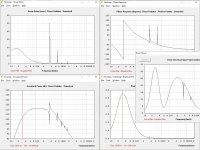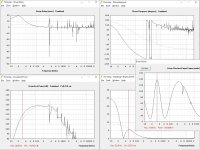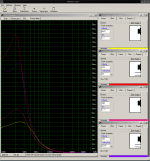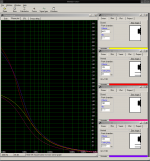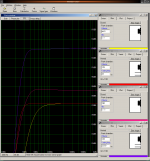A couple of questions regarding group delay. Number one, is there a link to a good "Group Delay for Dummies" explanation online? And second, Does a tapered TL essentially act like a normal ported enclosure with respect to group delay?
I would like to chip in that transient attack is important for good-sounding bass (this requires clean mid- and HF response) but transient decay is equally important but much more difficult to achieve.
"pitch precision and the absence of boom" is how the Linn 5150 is described in the manual. I can say from experience that they live up to those attributes. I have a pair that I use with my Acoustat Monitor 3. Isobaric configurations have gone unmentioned here. But control is where precision at the bottom end lives. Not only there, but my Acoustats are also isobarically set up with double panels and the improvement is equally apparent.
You might not, but there are many, many here who always do. It's absolutely astonishing that you think otherwise.However, the question, "What do you want your sub to do?" is rarely asked.
Oh, good grief, what a load of bollocks.Home Theatre subs are generally 'minimum wage'; offer maximum: grunt, growl, rumble, or boom when asked and they'll earn their keep. Even and rock and classical fans don't require too much finesse and precision in the lower frequencies. One note often blends into another.
Ever heard of John Entwhistle? He carried the melody for most of the Who's work for over 40y and he's only the OTTOMH example.These genres differ to many others because the bass is the lead, it's where the tune is.
Such stunning ignorance. When you can play better then Tony Levin, Pino Palladino, Paul McCartney, Geddy Lee, Stanley Clarke, Victor Wootten, Les Claypool, Lee Sklar (the most recorded bassist in history), Jaco Pastorious, Roger Waters, John Pattatucci, Bootsey Collins, James Jamerson, Verdine White, Larry Graham, Anthony Jackson, Oteil Burbidge, Doug Wimbish, Jimmy Johnson, Bobby Vega, Stu Hamm, Mark King, Ron Carter, Dee Murray, Sting, Lemmy Kilmister, Meshel Negdeocello, Tony Grey, Geoff Berlin, Billy Sheehan and Chuck Rainy come back and see us. Better still, recreate many of their performances with them just being sloppy and missing notes and tell me it sounds as good. Bring evidenceIn rock music the bass player is the butt of so many jokes because he's the talentless afterthought in the band - who cares if he misses a few notes?
He's OK, and good for slapping that well on a RH bass played LH with inverted stringing. Slapping isn't all that impressive to most bassists but if that sort of thing floats your boat, check out Charles Berthoud..You should WATCH this guy while LISTENING - he's really good!!
This shows you don't understand the subject. On a 4st bass the fundamental is typically well below the 2H from E1 to A1 as the standard 34" scale isn't long enough to support the fundamental. As most subs are below 80Hz only, there's actually very little a bass is contributing within it's range, so all you're talking about is the province of the midbass driver, not the sub.The first video shows a bass player. The question being does your sub clearly respond to everything his fingers are doing.
Honestly, I was not impressed by him.
I mean, Mark King
Neither Jacco. Technical ability is not where the music lives as mentioned above.
It's the tune.
Musicians are a dime a dozen, hence their starvation rate
I mean, Mark King
Neither Jacco. Technical ability is not where the music lives as mentioned above.
It's the tune.
Musicians are a dime a dozen, hence their starvation rate
Last edited:
If one is a competent designer, there is no distinction other than cost. My "music" sub, I originally had two but down sizing means one, is a critical Q sealed, Peerless XLSS paper carbon. It darn near matches roll-off to room gain. I have no EQ on my sub. Don't need it. My HT I run a pair of 10's,
That sounds like a Good Sub. But there are significant quantitatively measurable (and therefore simulatable) differences, and they're very definitely audible in the transient response.
The typical difference between a sealed and ported box at conservative tunings of about Q=0.7 is a delay of an extra quarter-wave near F3, which is what you get for it being a second-order resonant system with an extra moving mass. That puts the lowest octave of a ported enclosure in antiphase from the upper octaves, which is why the impulse response gets mashed - the lowest frequencies arrive so late through the port that they are inverted.
Room response. I can't stress it enough. It's the Q of what arrives at your ears that matters, not what the cone is doing.
With a port at maximum 'fling', the cone may be barely moving. And in much the same way, room modes can still turn 'tight' sealed subs into a mess with multiple resonances @ Q > 2 and 6dB peaks and dips just semitones apart. Depending on room dimensions, the cone can act like a node (region of minimum velocity), and 'fling' a large volume of air further out.
The physical principles of horns always apply, so it's a valuable body of knowledge to look into as well.
With a port at maximum 'fling', the cone may be barely moving. And in much the same way, room modes can still turn 'tight' sealed subs into a mess with multiple resonances @ Q > 2 and 6dB peaks and dips just semitones apart. Depending on room dimensions, the cone can act like a node (region of minimum velocity), and 'fling' a large volume of air further out.
The physical principles of horns always apply, so it's a valuable body of knowledge to look into as well.
Yeah and critical damping of qtc = 0.7 only applies outside because the room is usually like a really bad tractrix addon.The op is about "subs", not room response.🙂
maybe, but in my real world the performance of the sub is the most noticeable factor. No doubt those Linns would sound better in a treated room...however an upgrade is nevertheless so. I still realize the stated performance.
In most cheap and boomy commercial offerings: Kind of.That puts the lowest octave of a ported enclosure in antiphase from the upper octaves, which is why the impulse response gets mashed - the lowest frequencies arrive so late through the port that they are inverted.
You get a phase wrap from poor vented design, but you'll also see a somewhat compareable phase wrap if you use IIR or other analog EQ and filters to make the same response on a lower Q box of any type.
Use only a HP to protect the sub down low, and you get a phase disturbance.
If you use FIR then expect some serious delay in the signal chain... This being a subwoofer thread,
In most cheap and boomy commercial offerings: Kind of.
You get a phase wrap from poor vented design, but you'll also see a somewhat compareable phase wrap if you use IIR or other analog EQ and filters to make the same response on a lower Q box of any type.
Use only a HP to protect the sub down low, and you get a phase disturbance.
If you use FIR then expect some serious delay in the signal chain... This being a subwoofer thread,
I don't think there is any "kind of" to it. If you build a vented box, you are building a Helmholtz resonator which by definition containing an extra resonant moving mass, it will exhibit a 180+ degree phase difference between its tuning frequency and at HF. That is a fundamental outcome of the physics of its operation.
Cheap and boomy vented boxes I think have higher Q, so they store more energy, obtain higher SPL and have smearing of amplitude envelopes. They ring.
Not-cheap-and-boomy vented boxes designed in accordance with the usual rules for lowish Q (0.5-0.7) do not ring, but they do still have the phase shift due to being a resonator. As far as I can tell, it is an unavoidable outcome of using a port or passive radiator.
Yes of course you can bollocks up the response of a sealed box with filtering, but you don't have to 🙂
The box resonance limits membrane movement because of high resistance at a specific frequency, but in addition to the design it also depends where the port is placed if you'd actually get a phase wrap in relation to above port resonance because of it.
Here's the previous sim with the double 15" vented (black) vs sealed (gray), equal power (28,3v/two drivers), equal box volume (223 liters).
I use offset 2nd order Bessel around 200hz to almost-phase align.
No highpass unless I use them outdoors, 5,5mm xmax.
Was important to me to have resonance at the lowest point of most of my music collection, so I would not need a highpass filter.
Here's one more, if I adjust the response to be somewhat compareable with a Q 0,5 +5db 30hz boost and a 2nd order hp to protect the driver , I run out of xmax with only 35 watts, do note the somewhat similar phase and group delay with only these modest adjustments.
That's 107db/32W vs 115db/136W, quite the difference IMO.
Here's the previous sim with the double 15" vented (black) vs sealed (gray), equal power (28,3v/two drivers), equal box volume (223 liters).
I use offset 2nd order Bessel around 200hz to almost-phase align.
No highpass unless I use them outdoors, 5,5mm xmax.
Was important to me to have resonance at the lowest point of most of my music collection, so I would not need a highpass filter.
Here's one more, if I adjust the response to be somewhat compareable with a Q 0,5 +5db 30hz boost and a 2nd order hp to protect the driver , I run out of xmax with only 35 watts, do note the somewhat similar phase and group delay with only these modest adjustments.
That's 107db/32W vs 115db/136W, quite the difference IMO.
Attachments
Last edited:
The box resonance limits membrane movement because of high resistance at a specific frequency, but in addition to the design it also depends where the port is placed if you'd actually get a phase wrap in relation to above port resonance because of it.
Here's the previous sim with the double 15" vented (black) vs sealed (gray), equal power (28,3v/two drivers), equal box volume (223 liters).
I use offset 2nd order Bessel around 200hz to almost-phase align.
No highpass unless I use them outdoors, 5,5mm xmax.
Was important to me to have resonance at the lowest point of most of my music collection, so I would not need a highpass filter.
Here's one more, if I adjust the response to be somewhat compareable with a Q 0,5 +5db 30hz boost and a 2nd order hp to protect the driver , I run out of xmax with only 35 watts, do note the somewhat similar phase and group delay with only these modest adjustments.
That's 107db/32W vs 115db/136W, quite the difference IMO.
Those graphs illustrate what I mean very well. By using the port, you've gained 10dB more sensitivity (if I'm reading the relationship between the graphs correctly) rather than lower F3 - but that's a fine tradeoff that you can make. You can trade between lower F3 and higher SPL by adjusting box size and port tuning to suit your needs.
However, look at your phase graphs. On the ported box, the port tuning (from the impedance graph) is at 65Hz, and you can also see that that is the frequency at which the combined phase passes through -90deg, which is 180deg from the HF response at +90deg. So you have the classic 180degree phase shift of a helmholtz resonator.
You seem to have a similarly huge phase shift on the sealed version though, which is not necessary - it is possible to build sealed boxes with better response than that. I think it might be because you used the same box volume for both sealed and ported versions, whereas (for a given driver) each configuration needs a different volume for optimum behaviour.
I've attached three screenshots from an old version of WinISD. Yeah it's not the greatest sim, but it includes the necessary effects here for comparison purposes. There are four combinations shown:
- Adire Shiva sealed (yellow), achieves 87dB at HF and F3=38Hz with 90 deg phase shift at that point. Small box.
- Adire Shiva ported (red), achieves 87dB at HF and F3=22Hz but 180 deg phase shift. Medium box.
- Dayton UM18-22 sealed (pink), achieves 88dB at HF and F3=26Hz, with 90 deg phase shift. Large box & expensive driver.
- Dayton RSS460HO ported (purple), achieves 93dB at HF and F3=26Hz, with 160 deg phase shift. Medium box and expensive driver, but blows the doors off everything else except in phase coherence.
The red/yellow comparison shows you can reach lower and louder with a given driver using a port, but it will cost you in group delay. Sealed boxes are not a panacea - a sealed box is never going to match a ported box with the same driver in terms of making SPL down low.
The pink/red comparison shows that you can match the low SPL of any chosen ported box using a larger and more costly sealed solution, and it will sound better because it will have about half the group delay.
The purple/pink comparison says that since you were willing to spend big on a driver, why not go back to ported and get EVEN MOAR SPL. But it will cost you group delay again.
This "X >> Y" tradeoff ratchet can continue as long as your wallet holds out: two of the UM18-22 in a 360L box will give you the same SPL and F3 as the one RSS460HO, and they will fix the group delay! And if you're willing to buy two UM18s, you can probably afford a couple of 21" in a ported box, and eventually you have to change your name to Danley.
Attachments
Whatever are you talking about? It's not that different to what you're posting, only you have much more phase variance in your ported designs, other than that the only difference being wrapped vs unwrapped phase between our sims.You seem to have a similarly huge phase shift on the sealed version though, which is not necessary - it is possible to build sealed boxes with better response than that. I think it might be because you used the same box volume for both sealed and ported versions, whereas (for a given driver) each configuration needs a different volume for optimum behaviour.
This is why I did the comparison, the graphs with just the one sealed box that actually takes into account the limits of the driver as opposed to complete disregard in the comparison between sealed vs vented, has a 20hz 2nd order HP and a 0,51 Q +5db boost at 30hz, nothing more. If you schew the graphs to compare the phase shift between the "ported" and "sealed + eq and filter" enclosure you'd see that it's almost completely identical in regards to phase shift, group delay and phase. If I chuck the drivers in a smaller 100 liter volume it costs me 3db of output down low, nothing gained.
Bottom line: It does not matter for low SPL, no difference in SQ. As long as you take proper steps towards adapting the filter to the tops.
But: If I am certain that there's no content below 27hz the drivers can play much louder than if they where in a sealed box.
Whatever are you talking about? It's not that different to what you're posting, only you have much more phase variance in your ported designs, other than that the only difference being wrapped vs unwrapped phase between our sims.
In both of your sealed plots (first pic, and grey line in second pic), there is exactly 180 degrees of phase shift between 65Hz (your F3) and HF.
In the sealed plots I showed (yellow and pink lines), there is exactly 90 degrees between the F3 (38Hz and 26Hz, respectively) and HF.
Bottom line: It does not matter for low SPL, no difference in SQ. As long as you take proper steps towards adapting the filter to the tops.
I think we are talking at cross-purposes but saying somewhat the same thing. If you are comparing two box configurations with the same driver, you are correct, sealed is not some magic bullet that comes with a free lunch. But I am trying to say that with a larger and more expensive driver (there's that choice of a poison), you can get the same levels down low with better transient response. I don't think "you can build something better by spending more" should be contentious.
Funny sidebar which goes some way to highlight the difference between art and science. In some ways it doesn't matter what your spreadsheet says.
I write. We were attempting to write a parody scene. In Forrest Gump, Bubba is listing all the things you can do with shrimp. In the parody scene, a (high) studio engineer is listing all the different types of bass.
"Well, you got yer: Rolling bass, rumbling bass, growling bass, booming bass, sloppy bass, hollow bass, tight bass, boxy bass, bangin' bass, woolly bass, nasty bass, ugly bass, sweet bass, sexy bass, dry bass, slap bass, swinging bass, dirty bass, mellow bass . . ."
In the end the scene was scrapped, the list was exhaustive, making the scene too long.
I write. We were attempting to write a parody scene. In Forrest Gump, Bubba is listing all the things you can do with shrimp. In the parody scene, a (high) studio engineer is listing all the different types of bass.
"Well, you got yer: Rolling bass, rumbling bass, growling bass, booming bass, sloppy bass, hollow bass, tight bass, boxy bass, bangin' bass, woolly bass, nasty bass, ugly bass, sweet bass, sexy bass, dry bass, slap bass, swinging bass, dirty bass, mellow bass . . ."
In the end the scene was scrapped, the list was exhaustive, making the scene too long.
It won't to you, because you won't understand what it contains anyway.In some ways it doesn't matter what your spreadsheet says.
180 degrees is equal to flipping the polarity, but regardless of that phase is something to take into account at the crossover to the next driver, my vented enclosure has perhaps about 35 degrees more phase shift than the "virgin" sealed enclosure from 30-300Hz, the maximum range of this box with double 15" is intended as 27-300Hz. What happens below this frequency is for the most part uninteresting to me, based on analysis of my music collection, but I still get very nice in-room response to about 13hz for organ music when the mood strikes me.

35 degrees difference is hardly anything to write home about, just don't use a "textbook" filter because they never work that well anyway.
My point was that any highpass filter and/or moderate EQ you (or anyone else) might use for a closed sub will make an impact to much the same degree as if it was another type of design.
Type of design = Largely irrelevant
Have to look at the whole chain of components, the enclosure is just one of those components, albeit one with a myriad of variables in itself.
If you target equal response you'll end up mostly in the same place is what I'm saying. The only difference being that the closed box will be easier to calculate/more forgiving for any possible errors, requires more xmax, and does not allow for any accumulated heat to escape.
I just don't like it when people glorify one specific solution as "The Ultimate™", it is not correct.
I'm sure we agree for the most part.
Edit: And I do like closed boxes too, but as of right now I do not have any affinity towards any specific type of design. Well, expect "value for money" 😀
35 degrees difference is hardly anything to write home about, just don't use a "textbook" filter because they never work that well anyway.
My point was that any highpass filter and/or moderate EQ you (or anyone else) might use for a closed sub will make an impact to much the same degree as if it was another type of design.
Type of design = Largely irrelevant
Have to look at the whole chain of components, the enclosure is just one of those components, albeit one with a myriad of variables in itself.
I think we are talking at cross-purposes but saying somewhat the same thing. If you are comparing two box configurations with the same driver, you are correct, sealed is not some magic bullet that comes with a free lunch. But I am trying to say that with a larger and more expensive driver (there's that choice of a poison), you can get the same levels down low with better transient response. I don't think "you can build something better by spending more" should be contentious.
If you target equal response you'll end up mostly in the same place is what I'm saying. The only difference being that the closed box will be easier to calculate/more forgiving for any possible errors, requires more xmax, and does not allow for any accumulated heat to escape.
I just don't like it when people glorify one specific solution as "The Ultimate™", it is not correct.
I'm sure we agree for the most part.
Edit: And I do like closed boxes too, but as of right now I do not have any affinity towards any specific type of design. Well, expect "value for money" 😀
Last edited:
- Home
- Loudspeakers
- Subwoofers
- The test of a 'Muscial' Sub.
